“Sweet Cherries”
The new book “Sweet Cherries” by Lynn Long, professor emeritus at Oregon State University, Greg Lang of Michigan State University and Clive Kaiser of OSU, has recently been published by CABI as part of their Crop Production in Horticulture series. The book was written for beginning and established fruit growers, consultants and advisors, with a primary focus on fresh market sweet cherries. It provides comprehensive coverage of sustainable sweet cherry production, including global trends, improved varieties and rootstocks, orchard establishment and management, the physiology of growth and cropping, and protecting the crop from adverse climates, pests and diseases.
The authors emphasize sweet cherry production practices based on scientific principles, with generous illustrations throughout. They provide a foundational understanding of cherry tree growth and fruit development as the basis for grower decisions on the many choices of ever-evolving orchard practices and emerging challenges across diverse growing conditions and environments.
With the permission of CABI, Good Fruit Grower is reprinting a portion of Chapter 3, Cherry Flowering, Fruiting and Cultivars.
In the U.S. and other North and South American locations, the book can be ordered from: styluspub.presswarehouse.com/browse/book/9781786398284/Sweet-Cherries or from amazon.com. In the rest of the world, order the book directly from CABI at: www.cabi.org/bookshop/book/9781786398284/.
Planting new, largely untested cultivars is always a risk; however, there are several good reasons to diversify and expand the number of cultivars produced. When growing multiple cultivars, bloom times may be staggered, reducing the risk that the entire crop will be affected by poor weather during final flower development and pollination.
In addition, producing cultivars that range from early to late ripening times lengthens the growing season, spreading the risk of fruit cracking during ripening and potentially providing greater financial returns during market windows when supplies are limited. An extended harvest season also spreads out the demand for labor and improves labor efficiency. Cultivar diversification helps improve cropping consistency, and the risk of rain-cracked fruit can be reduced further by choosing cultivars with moderate to high resistance to rain-induced cracking.
The following 11 cultivars, of the 59 covered in the new book “Sweet Cherries,” were selected for inclusion in this article due to specific traits that may provide specific advantages to growers who are considering planting new, intensive cherry orchards. Traits of particular interest include unique harvest timing, very early to early ripening, large size and overall high quality.
Red-fleshed sweet cherries for the fresh market
(listed in approximate order of ripening):
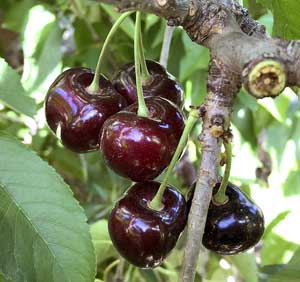
Cheery Treat
—Harvest timing: Very early season (12–14 days before Bing)
—Color when ripe: Light mahogany skin and flesh
—Bloom time: Early midseason
—Pollen S alleles: S1S(unnamed)
—Suggested rootstock productivity: Moderate to high
—Average fruit size: 30 mm (9-row)
—Average firmness: Good to excellent
—Fruit-cracking susceptibility: Low to moderate
Cheery Treat is a proprietary cultivar of International Fruit Genetics and is a high-quality, very early ripening cherry with large fruit and good flavor. Natural cracking rates in test plots indicate good to moderate rain-cracking resistance. A large percentage of the fruit is borne on annual wood, similar to Regina, so training systems that remove 1-year-old wood, such as KGB and UFO, should be avoided. One of Cheery Treat’s two alleles is very rare and has never been documented in the literature, so nearly any early- to midblooming variety will work as a pollinizer.
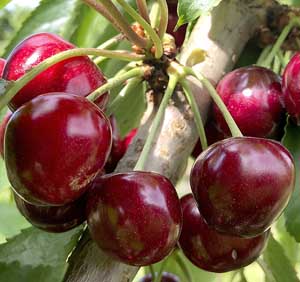
Cheery Grand
—Harvest timing: Very early season (10–12 days before Bing)
—Color when ripe: Red to light mahogany skin and flesh
—Bloom time: Midseason
—Pollen S alleles: S6S9
—Suggested rootstock productivity: Moderate to high
—Average fruit size: 30–32 mm (9- to 8.5-row)
—Average firmness: Good
—Fruit-cracking susceptibility: Moderate
Cheery Grand is a proprietary cultivar of International Fruit Genetics. Fruit ships well to distant markets. It has good flavor but can be a bit acidic if harvested before it is fully ripe. The tree is open and crops consistently. Gibberellic acid and calcium treatments may be needed to enhance firmness. Pedicels are moderately long and retain their green color during storage.
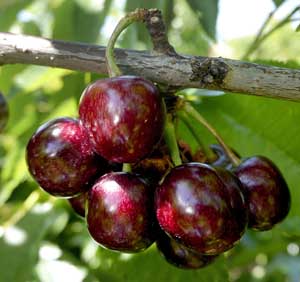
Royal Hazel
—Harvest timing: Early season (10 days before Bing)
—Color when ripe: Light mahogany skin and flesh
—Bloom time: Early season
—Pollen S alleles: S4S6
—Suggested rootstock productivity: Low to moderate
—Average fruit size: 30 mm (9-row)
—Average firmness: Excellent
—Fruit-cracking susceptibility: Low to moderate
Royal Hazel was bred by Zaiger Genetics of California and therefore has a low chilling requirement (about 500 hours), tends to be very productive and sets very heavy crops, even in years with some frost. The flavor and fruit quality are very good, especially for such an early ripening cherry.
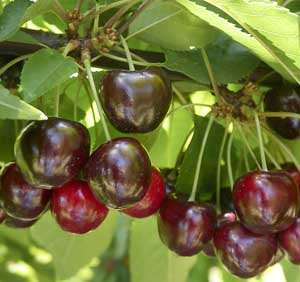
Black Pearl
—Harvest timing: Early season (7 days before Bing)
—Color when ripe: Mahogany to very dark mahogany skin and flesh
—Bloom time: Midseason
—Pollen S alleles: S4S13
—Suggested rootstock productivity: Low to moderate
—Average fruit size: 30 mm (9-row)
—Average firmness: Extraordinary
—Fruit-cracking susceptibility: Low to moderate
Black Pearl is a large, very firm cherry for the early season market, with a good flavor that is rare for this harvest timing. The tree is rather upright and can be very productive on Gisela rootstocks. Aborted fruit do not drop cleanly from the tree but can be easily sorted in the packing house; ripe fruit can hang on the tree for a long time with no loss of firmness. Fruit pitting incidence is lower than average in laboratory tests.
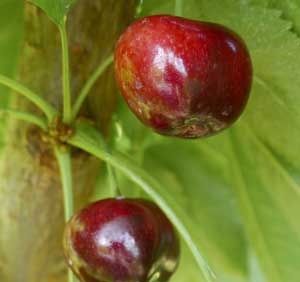
Coral Champagne (aka Coral)
—Harvest timing: Early season (7 days before Bing)
—Color when ripe: Pink to bright red skin, dark red flesh
—Bloom time: Midseason
—Pollen S alleles: S1S3
—Suggested rootstock productivity: Low to moderate
—Average fruit size: 30 mm (9-row)
—Average firmness: Excellent
—Fruit-cracking susceptibility: Moderate
Coral Champagne fruit is very sweet with an impression of low acid, although it’s still quite flavorful. The skin color is light red, but the flesh is dark. It has proven suitable for lower chill areas, becoming the third most widely produced cherry in California, but planting is also increasing in the Pacific Northwest region. The tree is precocious and productive.
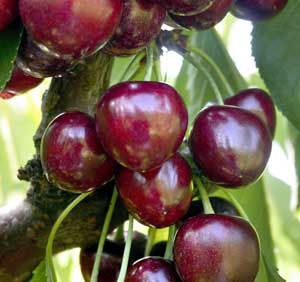
Burgundy Pearl
—Harvest timing: Early midseason (4–5 days before Bing)
—Color when ripe: Mahogany to dark mahogany skin and flesh
—Bloom time: Midseason
—Pollen S alleles: S3S4
—Suggested rootstock productivity: Moderate to high
—Average fruit size: 31 mm (8.5-row)
—Average firmness: Extraordinary
—Fruit-cracking susceptibility: Moderate
Burgundy Pearl fruit has a crunchy firmness and a mild but good flavor. The tree reportedly has some resistance to bacterial canker; in some regions, flower buds have been reported to be more susceptible to cold damage than other cultivars.
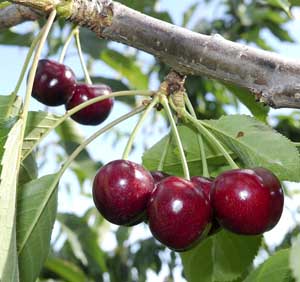
Ebony Pearl
—Harvest timing: Midseason (with Bing)
—Color when ripe: Mahogany to dark mahogany skin and flesh
—Bloom time: Midseason
—Pollen S alleles: S1S4
—Suggested rootstock productivity: Moderate to high
—Average fruit size: 32 mm (8.5-row)
—Average firmness: Excellent
—Fruit-cracking susceptibility: Low
Ebony Pearl fruit has an excellent flavor, better size and better resistance to rain-cracking than Bing. The tree is open, spreading and reportedly less susceptible to bacterial canker than Bing.
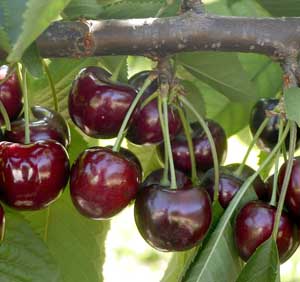
Tamara
—Harvest timing: Mid- to late season (6–8 days after Bing or Van)
—Color when ripe: Mahogany
—Bloom timing: Mid- to late season
—Pollen S alleles: S1S9
—Suggested rootstock productivity: Low to moderate
—Average fruit size: 32 mm (8.5-row)
—Average firmness: Excellent
—Fruit-cracking susceptibility: Low
Tamara fruit is very high quality with excellent flavor and very low pitting potential. Stem retention may be a problem during harvest or postharvest handling. Proper harvest timing is essential, as fruit quickly becomes overripe.
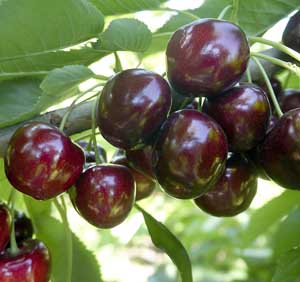
Royal Edie
—Harvest timing: Late season (13 days after Bing or Van)
—Color when ripe: Mahogany skin and flesh
—Bloom time: Midseason
—Pollen S alleles: S1S4 (though some reports indicate self-incompatible)
—Suggested rootstock productivity: Moderate to high
—Average fruit size: 32 mm (8.5-row)
—Average firmness: Excellent to extraordinary
—Fruit-cracking susceptibility: Moderate to high
Royal Edie was bred by Zaiger Genetics. The fruit has an excellent sweet/acid flavor and long, thick stems that are securely attached. The tree growth habit is rather upright.
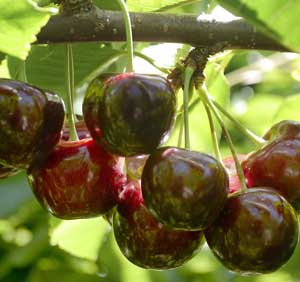
Royal Helen
—Harvest timing: Late season (13 days after Bing)
—Color when ripe: Mahogany skin and flesh
—Bloom time: Midseason
—Pollen S alleles: S1S4 (though some reports indicate self-incompatible)
—Suggested rootstock productivity: Moderate to high
—Average fruit size: 32 mm (8.5-row)
—Average firmness: Excellent
—Fruit-cracking susceptibility: Moderate
Royal Helen was bred by Zaiger Genetics. The fruit has a pleasant flavor, but pitting incidence is higher than average in laboratory tests. Although it ripens in the Pacific Northwest region around Regina timing, harvest in California is generally about a week after Bing. The tree growth habit is upright.
Yellow-fleshed blush sweet cherries for the fresh market:
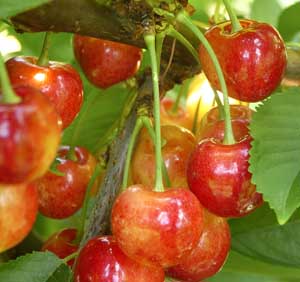
Radiance Pearl
—Harvest timing: Midseason (1–2 days before Rainier)
—Color when ripe: Yellow skin with red blush, yellow flesh
—Bloom time: Late midseason
—Pollen S alleles: S1S13
—Suggested rootstock productivity: Low to moderate
—Average fruit size: 31 mm (8.5-row)
—Average firmness: Extraordinary
—Fruit-cracking susceptibility: Moderate
Radiance Pearl fruit has a very good eating quality and a pitting incidence lower than average in laboratory tests; the fruit are very firm. The tree is open and spreading, with the potential to overset unless crop load is properly managed.
—by Lynn Long, Greg Lang and Clive Kaiser






Leave A Comment